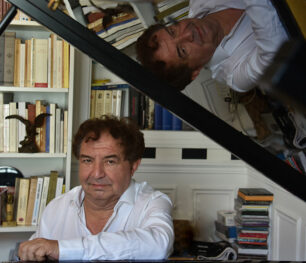…explosante fixe…, Répons, Dialogue de l’ombre double, Anthèmes II sont autant d’œuvres mixtes (alliages de sons instrumentaux et électroniques) qui balisent le catalogue de Pierre Boulez, fondateur d’une institution phare en la matière : l’Institut de recherche et de coordination acoustique/musique (Ircam). Cette institution a façonné les parcours respectifs de Yan Maresz et Philippe Manoury. Compositeur, bâtisseur de culture, Pierre Boulez est également un éminent chef d’orchestre qui a porté au disque El retablo de Maese Pedro et le Concerto pour clavecin de Manuel de Falla.
Chants et champs de la musique mixte
Natif de Monaco, Yan Maresz s’est formé aux États-Unis (guitare jazz, arrangement, orchestration) avant de se consacrer plus spécifiquement à la composition. Au début des années 1990, il retraverse l’Atlantique et rejoint la formation en composition et informatique musicale de l’Ircam. La fin de son « cursus » est marquée par la création de Metallics (1995) pour trompette solo et dispositif électronique. Cette idée d’interaction et de dialogue entre sources acoustiques et électroniques va, depuis lors, nourrir considérablement l’imaginaire sonore du compositeur.
Dans Soli, le compositeur explore la notion de duo entre le piano (présent physiquement sur scène) et l’électronique qui, selon son souhait, « fait sonner l’espace à la manière d’un instrument physique ». Pour réaliser concrètement cette aspiration, Yan Maresz fait appel au système IKO. Ce dispositif, qui prend la forme d’un icosaèdre placé aux côtés du pianiste, permet de diffuser le son généré par l’électronique dans toutes les directions (comme le ferait un instrument). Cette écriture dialoguée est renforcée par le fait que le contenu de la partie électronique est directement dérivé de sons de pianos (préparés ou non). Dialogues, oppositions, fusions, telle est la grammaire de ce solo à deux dans lequel acoustique et électronique, piano réel et imaginaire sont à parts égales.
Depuis les années 1980, Philippe Manoury mène un infatigable travail de recherche dans le domaine de l’informatique musicale (notamment à l’Ircam) et le répertoire mixte tient logiquement une place de choix dans son catalogue. Clin d’œil au Wohltemperierte Klavier (Clavier bien tempéré) de Johann Sebastian Bach, Das Wohlpräparierte Klavier présente une autre forme d’exploration du lien entre acoustique et électronique. Il s’agit cette fois d’une grande forme, d’un seul tenant, qui s’étend sur près de trente-quatre minutes de musique. Bien qu’elle soit pensée en un bloc, la pièce est toutefois articulée en deux grands « panneaux » (pour reprendre la terminologie du compositeur) : une « fantaisie » et une « sonate ». Quatre interludes, de forme plus libre, agissent comme des respirations dans le discours.
Philippe Manoury s’intéresse tout particulièrement ici à la notion d’attraction sonore qu’il compare volontiers au phénomène de flocking (volée) chez les oiseaux. Au début de la pièce, le public est immédiatement immergé dans le son électronique. On y perçoit différentes couches qui semblent mutuellement s’influencer. D’une manière générale, quatre couches en perpétuelle évolution se déploient dans l’ensemble de l’œuvre. En fonction des contextes, une couche peut prendre le lead sur les trois autres même si le piano reste l’activateur principal de toute la partition électronique. Comme chez Maresz, cette électronique n’est pas figée, mais converse avec le pianiste à la manière d’un interprète virtuel.
Figure d’Espagne
Au tournant des XIXe et XXe siècles, une fascination réciproque s’exerce entre la France et l’Espagne. Côté français, cette péninsule est perçue comme un ailleurs à portée de main et dont le folklore permet de revivifier le langage et l’écriture instrumentale. Côté espagnol, il n’est pas rare de se rendre ou de se former à Paris dans un contexte de bouillonnement artistique et culturel. C’est notamment le cas d’Albéniz, Rodrigo, Turina ou encore Manuel de Falla, autant de figures marquantes du renouveau de la musique espagnole.
Le Gaditan s’installe à Paris entre 1907 et 1914. Il y fait la rencontre de Claude Debussy et Maurice Ravel et se lie d’amitié avec Paul Dukas. Quelques années après ce séjour parisien, le compositeur ibérique rédige sa Fantasia Batica (terme latin désignant l’Andalousie) à la suite d’une commande du pianiste virtuose Arthur Rubinstein. Le commanditaire considérera l’œuvre comme austère, sévère et ne l’intègrera pas à son répertoire régulier. Pourtant, cette fantaisie tripartite regorge de références au flamenco. Dans les sections rapides, l’écriture pianistique flirte volontiers avec le jeu de la guitare tandis que la section centrale plus lyrique fait explicitement référence aux mélodies du cante jondo (sources les plus anciennes du flamenco).
Plus tardif, Pour le tombeau de Paul Dukas (1935) s’inscrit dans la tradition littéraire des hommages. Il est intégré à un ouvrage collectif de neuf pièces composées à la mémoire du compositeur français. Dans cette courte élégie en fa mineur, Manuel de Falla glisse un clin d’oreille posthume à son ami outre-pyrénéen en citant un thème du troisième mouvement de sa Sonate en mi bémol mineur. Pour le tombeau… existe également dans une version pour orchestre insérée dans la suite Homenajes (Hommages) aux côtés d’une page dédiée à Claude Debussy.
Nicolas Munck







